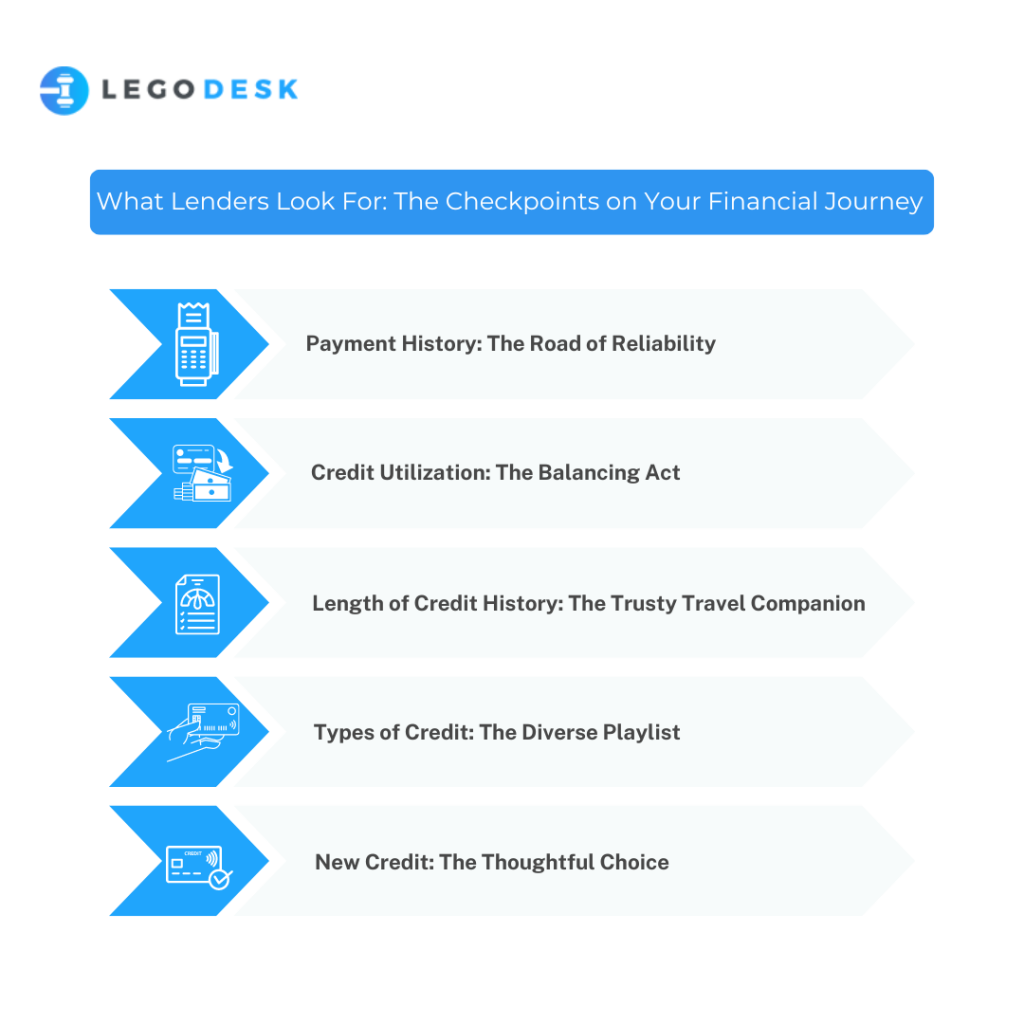Navigating Credit Score Ranges: What Lenders Look For
Embarking on a journey into the world of credit scores can feel like navigating an intricate maze. But fear not, as we unravel the mysteries of credit score ranges and demystify what lenders are really looking for. Join us on this straightforward exploration, where we break down the complexities and make understanding credit scores as easy as counting 1-2-3.
I. Credit Score Ranges: The Stages of Financial Fitness
A. Poor Credit (300-579): The Starting Line
Imagine poor credit as the starting line in the race of financial fitness. Lenders here might raise an eyebrow, wondering if you’ve stumbled before. The key? Clear the path by addressing debts, paying bills on time, and seeking guidance if you’ve hit a financial roadblock.
B. Fair Credit (580-669): The Uphill Climb
Moving up, fair credit is like climbing a hill. It gets a bit steeper, and lenders might charge a bit more for the view. They want to see steady payments and efforts to reduce debts. Tackle this incline by paying bills on time and chipping away at what you owe.
C. Good Credit (670-739): The Pleasant Plateau
Reaching good credit is like finding a serene plateau. Lenders here smile upon those with a track record of on-time payments, manageable credit card balances, and a variety of credit types. To maintain this serene spot, focus on keeping your credit usage in check and nurturing a mix of credit.
D. Very Good Credit (740-799): The Scenic Summit
Venturing higher, very good credit is the scenic summit where lenders applaud responsible credit use. Competitive interest rates and premium credit card offers await. Keep the view pristine by maintaining low credit card balances, avoiding unnecessary credit accounts, and continuing timely payments.
E. Excellent Credit (800-850): The Pinnacle of Financial Peaks
At the top of the credit mountain is excellent credit. Lenders roll out the red carpet here, offering the best terms to those with impeccable credit histories. Preserve this pinnacle by practicing sound financial habits and relishing in the rewards of your financial peak.
II. What Lenders Look For: The Checkpoints on Your Financial Journey

I. Payment History: The Road of Reliability
Picture your payment history as the road of reliability—a winding path that showcases your financial commitment. Lenders, like seasoned travelers, value a trustworthy route. On-time payments serve as signposts of your reliability, marking each milestone in your financial journey. Late payments, on the other hand, are like unexpected roadblocks, causing lenders to question the smoothness of your financial route.
To make this journey interesting, think of your payment history as a gripping narrative. Each timely payment adds a plot twist of financial responsibility, while late payments introduce suspense and uncertainty. Navigate this road with precision, ensuring that your financial story is one of unwavering reliability.
II. Credit Utilization: The Balancing Act
Enter the world of credit utilization—a delicate balancing act that lenders keenly observe. Think of it as a tightrope walk where staying centered is key. Lenders appreciate borrowers who don’t lean too heavily on credit, maintaining a balance between credit usage and available limits.
To make this checkpoint interesting, envision credit utilization as a high-stakes performance. Your credit balances are the tightrope, and lenders are the audience. Keep the act thrilling by demonstrating financial agility—managing your credit balances with finesse. Avoid tipping the scales too much in either direction, as this balancing act is a show that lenders eagerly watch.
III. Length of Credit History: The Trusty Travel Companion
As we journey further, we encounter the length of credit history—a trusty travel companion that lenders hold in high regard. Imagine this companion as a seasoned guide, providing insights into your financial past. The longer the companionship, the more trust it garners from lenders.
To infuse intrigue into this aspect, think of your credit history as an ancient manuscript. Each page tells a tale of your financial exploits, victories, and occasional challenges. Lenders, like historians, seek a rich and well-documented story. Nurture this trusty companion by preserving old accounts, showcasing the resilience of your financial journey through the ages.
IV. Types of Credit: The Diverse Playlist
Our journey takes a musical turn as we explore the types of credit—a diverse playlist that lenders find harmonious. Envision your credit portfolio as a symphony, with each instrument representing a different type of credit. Lenders, like music aficionados, appreciate the depth and variety in your financial melody.
To make this checkpoint engaging, consider your credit mix as a carefully curated playlist. Include different instruments—credit cards, installment loans, mortgages—to create a financial symphony that captivates lenders. This diversity adds layers to your credit composition, making it an appealing and intriguing piece for lenders to enjoy.
V. New Credit: The Thoughtful Choice
Our final checkpoint introduces the concept of new credit—a thoughtful choice in the ever-evolving financial landscape. Visualize seeking new credit as embarking on a new adventure. Lenders value borrowers who make strategic choices, ensuring that each credit inquiry aligns with their financial goals.
To inject interest into this aspect, think of new credit as chapters in an unfolding novel. Each inquiry adds a plot twist, shaping the narrative of your financial story. Make each chapter count by being intentional about the credit you seek, showcasing to lenders that your financial journey is one of purpose and careful consideration.
Conclusion
Navigating the world of credit scores range doesn’t have to be a complex quest. With a clear understanding of the checkpoints and stages of financial fitness, you can confidently steer your financial journey. Whether you’re starting at the bottom or reveling in the pinnacle, the key is to stay on course, making informed decisions that lead to a brighter financial future.